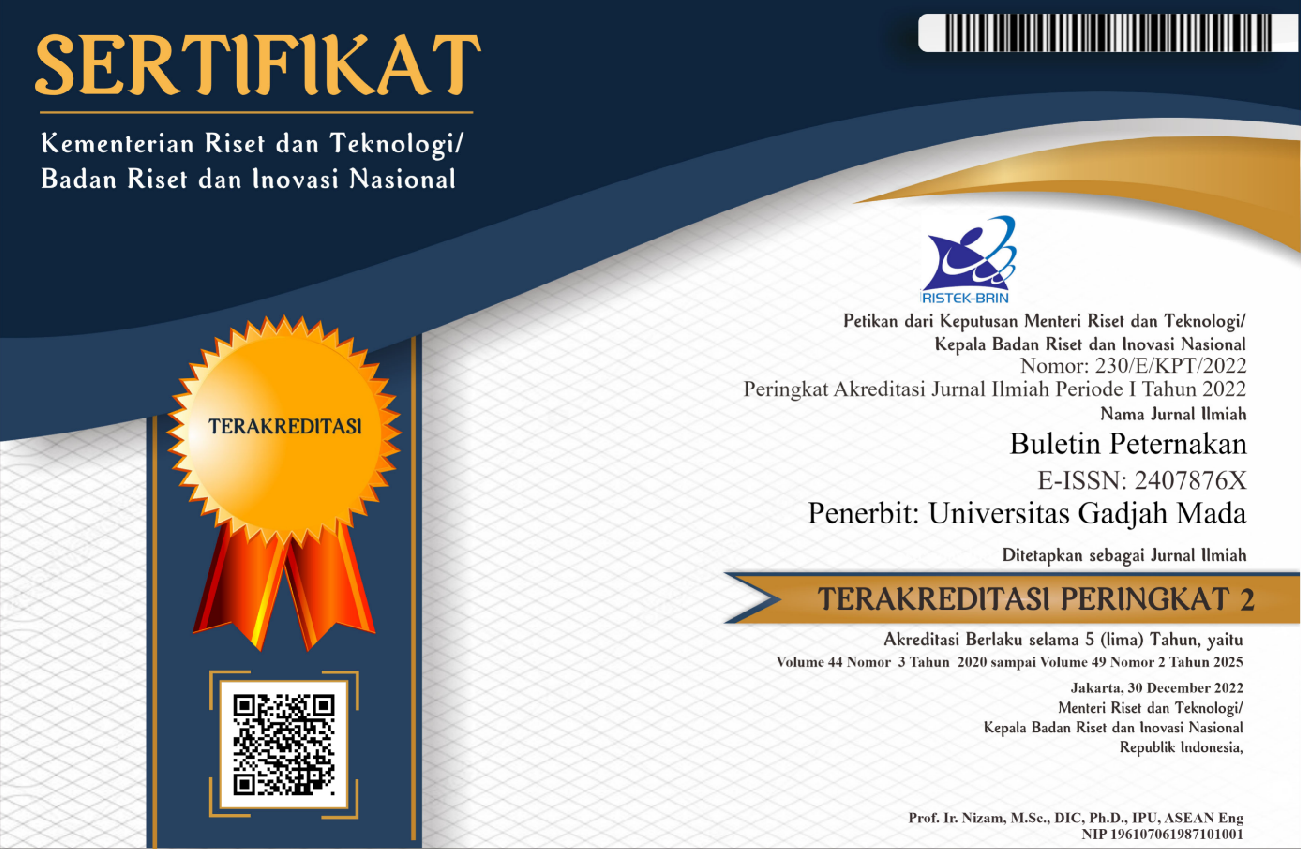Carcass Quality, Non-Carcass Component and Meat Cholesterol of Kacang Goat Fed with Fermented Cocoa Shell
Edi Suryanto(1*), Bulkaini Bulkaini(2), Soeparno Soeparno(3), Mastur Mastur(4)
(1) Fak Peternakan UGM
(2) Fakultas Peternakan, Universitas Mataram
(3) Fakultas Peternakan UGM
(4) Fakultas Peternakan Universitas Mataram
(*) Corresponding Author
Abstract
Keywords
Full Text:
PDFReferences
Alemawor, F.,V. P. Dzogbefial, E. O. K. Oddoye and J. H. Oldham. 2009. Effect of pleurotus ostreatus fermentation on cocoa pod husk composition: influence of fermentation period and mn2+ supplementation on the fermentation process. African J. Biotechnol. 8: 1950-1958.
Amirroenas, D. E. 1990. Mutu ransum berbentuk pellet dengan bahan serat biomassa pod coklat (Theobroma cocoa L) untuk pertumbuhan sapi perah jantan. Tesis. Fakultas Pascasarjana. Institut Pertanian Bogor, Bogor.
Arora, S. P. 1992. Pencernaan Mikrobia pada Ruminansia. Gadjah Mada University Press, Yogyakarta.
BPS. 2013. Produksi kakao di Indonesia. Badan Pusat Statistik, Jakarta.
Gamayanti, K. N., A. Pertiwiningrum, and L. M. Yusiati. 2012. Pengaruh penggunaan limbah cair rumen dan lumpur gambut sebagai starter dalam proses fermentasi metanogenik. Buletin Peternakan 36: 32-39.
Indraningsih and Y. Sani. 2005. Kajian kontaminasi pestisida pada limbah padi sebagai pakan ternak dan alternatif penanggulangannya. Prosiding Seminar Nasional Pengembangan Usaha Peternakan Berdaya Saing di Lahan Kering. Puslitbang Peternakan – UGM. Yogyakarta, Agustus 2005, Hal 108-119.
Indraningsih, R. Widiastuti and Y. Sani. 2006. Upaya pengembangan peternakan kerbau dalam menunjang kecukupan daging. Prosiding lokakarya nasional usaha ternak kerbau mendukung program kecukupan daging sapi 2006, Puslitbang Peternakan, ISBN:979-8308-58-1, di Sumbawa, Provinsi NTB pada tanggal 4-5 Agustus 2006. Hal 124-140.
Lateef, A., J. K. Oloke, E. B. Gueguim-Kana, S. O. Oyeniyi, O. R. Onifade, A. O. Oyeleye, O. C. Oladusu and A. O. Oyelami. 2008. Improving the quality of agro-wastes by solid-state fermentation: enhanced antioxidant activities and nutritional qualities. World J. Microbiol. Biotechnol. 24: 2369-2374.
Munier, F. F. 2009. Potensi ketersediaan kulit buah kakao (Theobroma cocoa l) sebagai sumber pakan alternatif untuk ternak ruminansia di Daerah Istimewa Yogyakarta. Prosiding Seminar Nasional Teknologi Peternakan dan Veteriner: Teknologi Peternakan dan Veteriner Mendukung Industrialisasi Sistem Pertanian untuk Meningkatkan Ketahanan Pangan dan Kesejahteraan Peternak, Bogor, 13-14 Agustus 2009. Pp. 752-759.
Omed, H. M., D. K. Lovetland, and R. F. E. Axford. 2000. Faeces as a source of microbial enzymes for estimating digestibility. In: Forage Evaluation in Ruminant Nutrition. D.I. Givens, E.Owen, F.R.E. Axford and H.M. Omed (Eds.), CABI Publishing, New York Pp. 135-150.
Purbowati, E., E. Rianto, W. S. Dilaga, C. M. S. Lestari and R. Adiwinarti. 2014. Karakteristik cairan rumen, jenis dan jumlah mikrobia dalam rumen sapi Jawa dan Peranakan Ongole. Buletin Peternakan 38: 21-26.
Ransaleleh, T. A. 1998. Nilai perbandingan dan kualitas daging sapi Brahman cross pada kelompok bobot potong yang berbeda. Tesis. Program Pascasarjana Institut Pertanian Bogor, Bogor.
Saidin, M. 2000. Kandungan kolesterol dalam berbagai bahan makanan hewani. Buletin Pusat Penelitian dan Pengembangan Gizi, Badan Penelitian dan Pengembangan Kesehatan, Departemen Kesehatan, Republik Indonesia. 27: 224-230.
Sodiq, A. 2011. Prediksi bobot dan konformasi karkas kambing lokal menggunakan prediktor bobot potong dengan berbagai model regresi. Jurnal Agripet 11: 1-7.
Soeparno. 2015. Ilmu dan Teknologi Daging. Edisi kedua, Gadjah Mada University Press, Yogyakarta.
Steel, R. G. D. and J. H. Torrie. 1980. Principles and Procedures of Statistics. McGraw-Hill Book Co. Inc., New York.
Sunarlim, R. and S. Usmiati. 2006. Profil karkas ternak domba dan kambing. Prosiding Seminar Nasional Teknologi Peternakan dan Veteriner. Balai Besar Penelitian dan Pengembangan Pasca Panen Pertanian, Bogor.
Suryanto, E., Bulkaini, Ashari and I. W. Karda. 2014. Carcass quality, Marbling and cholesterol content of male Bali cattle fed fermented cocoa shell. J. Indonesian Trop. Anim. Agric. 39: 249-255.
Thohari, I., Susrini and B. Yuniar. 2007. The effect of garlic extract addition the cholesterol content of male castrated crossbreed boer meat. Jurnal Ilmu dan Teknologi Hasil Ternak. 2: 1-5.
Wiyatna, M. F. 2007. Perbandingan indeks daging sapi-sapi Indonesia (sapi Bali, Madura, PO) dengan sapi Australian Commercial Cross (ACC). Jurnal Ilmu Ternak 7: 22-25.
Yosita, M., S. Undang and E. Y. Setyowati. 2012. Persentase karkas, tebal lemak punggung dan indekss perdagingan sapi Bali, Peranakan Ongole dan Australian Commersial Cross. http://jurnal.unpad.ac.id/ejournal/article/view/887. Accessed 20 February 2018.
Van Elswyk, M. E. and S. H. Mc Neill. 2014. Impact of grass/forage feeding versus grain finishing on beef nutrients and sensory quality: The U.S. experience. Meat Science. 96: 535-540.
Article Metrics
Refbacks
- There are currently no refbacks.

This work is licensed under a Creative Commons Attribution-ShareAlike 4.0 International License.
Buletin Peternakan (Bulletin of Animal Science) Indexed by:

This work is licensed under a Creative Commons Attribution-ShareAlike 4.0 International License.









